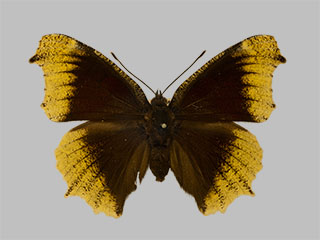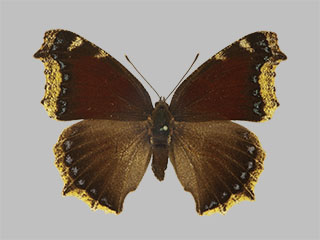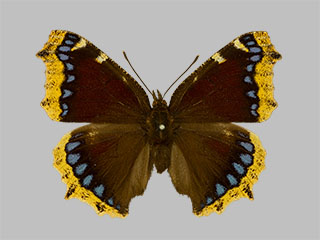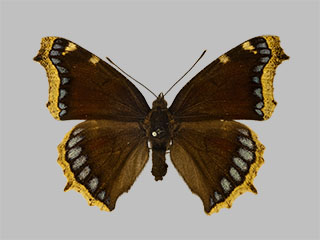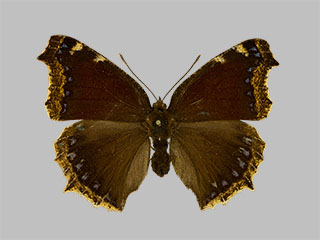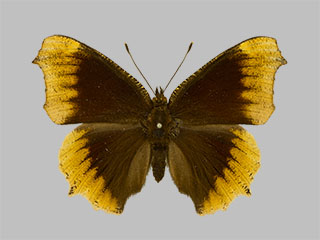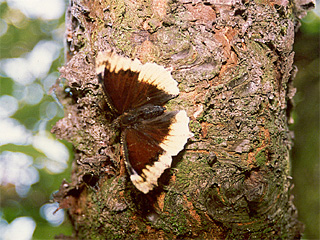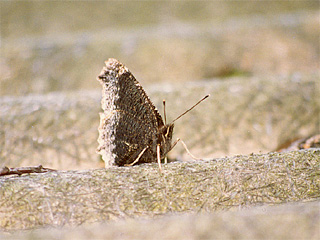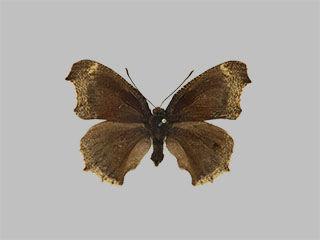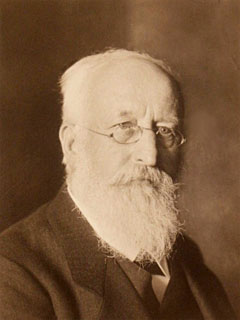|
|
|
|
The following A genetic or environmentally produced variation on the usual form of the speciesaberrations1 of  Camberwell BeautyNymphalis antiopa (Linnaeus, 1758)Mourning CloakCamberwell Beauty are described:
Camberwell BeautyNymphalis antiopa (Linnaeus, 1758)Mourning CloakCamberwell Beauty are described:
-
 Nymphalis antiopa f. artemisNymphalis antiopa f. artemis (Linnaeus, 1758)Nymphalis antiopa f. artemis Fischer [=Nymphalis antiopa f. roederiNymphalis antiopa f. roederi (Linnaeus, 1758)Nymphalis antiopa f. roederi Stdf.]
Nymphalis antiopa f. artemisNymphalis antiopa f. artemis (Linnaeus, 1758)Nymphalis antiopa f. artemis Fischer [=Nymphalis antiopa f. roederiNymphalis antiopa f. roederi (Linnaeus, 1758)Nymphalis antiopa f. roederi Stdf.] -
 Nymphalis antiopa f. daubiiNymphalis antiopa f. daubii (Linnaeus, 1758)Nymphalis antiopa f. daubii
Nymphalis antiopa f. daubiiNymphalis antiopa f. daubii (Linnaeus, 1758)Nymphalis antiopa f. daubii -
Nymphalis antiopa f. dorfmeisteriNymphalis antiopa f. dorfmeisteri (Linnaeus, 1758)Nymphalis antiopa f. dorfmeisteri Fischer
-
Nymphalis antiopa f. epioneNymphalis antiopa f. epione (Linnaeus, 1758)Nymphalis antiopa f. epione Fischer
-
Nymphalis antiopa f. heppeiNymphalis antiopa f. heppei (Linnaeus, 1758)Nymphalis antiopa f. heppei
-
 Nymphalis antiopa f. hygiaeaNymphalis antiopa f. hygiaea (Linnaeus, 1758)Nymphalis antiopa f. hygiaea Heydenreich, 1851
Nymphalis antiopa f. hygiaeaNymphalis antiopa f. hygiaea (Linnaeus, 1758)Nymphalis antiopa f. hygiaea Heydenreich, 1851 -
Nymphalis antiopa f. obscuraNymphalis antiopa f. obscura (Linnaeus, 1758)Nymphalis antiopa f. obscura Gönner
-
Nymphalis antiopa f. roederiNymphalis antiopa f. roederi (Linnaeus, 1758)Nymphalis antiopa f. roederi Standfuss, 1896
See also Research about temperature effects.
1There are different opinions as to when a deviation is categorised as an aberration or, for example, as individual variation. Here, the number of individuals can be a distinguishing feature, but also the origin of the aberration. For example, the deviation may have arisen due to genetic or climatic factors. Furthermore, it is difficult to define the boundary between aberrations and individual variations. To the best of my knowledge, there is currently no generally recognised clear definition of the term aberration.
 Nymphalis antiopa f. artemisNymphalis antiopa f. artemis (Linnaeus, 1758)Nymphalis antiopa f. artemis Fischer [= Nymphalis antiopa f. roederiNymphalis antiopa f. roederi (Linnaeus, 1758)Nymphalis antiopa f. roederi Stdf.]
Nymphalis antiopa f. artemisNymphalis antiopa f. artemis (Linnaeus, 1758)Nymphalis antiopa f. artemis Fischer [= Nymphalis antiopa f. roederiNymphalis antiopa f. roederi (Linnaeus, 1758)Nymphalis antiopa f. roederi Stdf.]
In Fischer, 1894 - Zwei neue Aberrationen von Vanessa antiopa, the Zurich physician and entomologist Emil Fischer (1868-1954)Emil Fischer describes his A genetic or environmentally produced variation on the usual form of the speciesaberrations artificially produced in the summer of 1894 during temperature experiments as Vanessa antiopa aberratio Artemis Fischer.
The black pre-border of the upper side of the wings is broader, sometimes to such an extent that the brown ground colour is almost displaced. The yellow border is narrower. The blue spots are enlarged and sometimes take on the shape of arrowheads with double barbs.
The A genetic or environmentally produced variation on the usual form of the speciesaberration is caused by temperatures just above freezing during the pupal phase, but can also occur when the temperature rises to 40-42ºC.
 Nymphalis antiopa f. artemisNymphalis antiopa f. artemis (Linnaeus, 1758)Nymphalis antiopa f. artemis by Emil Fischer (1868-1954)Emil Fischer (1894) are the same A genetic or environmentally produced variation on the usual form of the speciesaberration. For details see Forms/Aberrations (f. roederi).
Nymphalis antiopa f. artemisNymphalis antiopa f. artemis (Linnaeus, 1758)Nymphalis antiopa f. artemis by Emil Fischer (1868-1954)Emil Fischer (1894) are the same A genetic or environmentally produced variation on the usual form of the speciesaberration. For details see Forms/Aberrations (f. roederi). Camberwell BeautyNymphalis antiopa (Linnaeus, 1758)Mourning CloakCamberwell Beauty
Camberwell BeautyNymphalis antiopa (Linnaeus, 1758)Mourning CloakCamberwell Beauty
Nymphalis antiopa f. artemis
[65 mm]
ab. flarv. maculata
Collection: Museum Alexander Koenig, Bonn
Subcollection: ex coll. Missionshaus SVD Steyl (Eing.Nr.3/59)
 Camberwell BeautyNymphalis antiopa (Linnaeus, 1758)Mourning CloakCamberwell Beauty
Camberwell BeautyNymphalis antiopa (Linnaeus, 1758)Mourning CloakCamberwell Beauty
Nymphalis antiopa f. artemis
[Breeding image; 68 mm]
Temperature experiments Karl Frings, Bonn: 42 days +6°C. 8 ab.
Collection: Museum Alexander Koenig, Bonn
Breeding:
Karl Frings (1874-1931)Karl Frings; Bonn,  GermanyBonn,
GermanyBonn,  Germany
Germany Germany (1898/1904)
Germany (1898/1904)
For more specimens of the A genetic or environmentally produced variation on the usual form of the speciesaberration  Nymphalis antiopa f. artemisNymphalis antiopa f. artemis (Linnaeus, 1758)Nymphalis antiopa f. artemis see: Photos of pinned Camberwell beauties (Nymphalis antiopa): Nymphalis antiopa f. artemis.
Nymphalis antiopa f. artemisNymphalis antiopa f. artemis (Linnaeus, 1758)Nymphalis antiopa f. artemis see: Photos of pinned Camberwell beauties (Nymphalis antiopa): Nymphalis antiopa f. artemis.
On the naming of the A genetic or environmentally produced variation on the usual form of the speciesaberration  Nymphalis antiopa f. artemisNymphalis antiopa f. artemis (Linnaeus, 1758)Nymphalis antiopa f. artemis see Scientific Names.
Nymphalis antiopa f. artemisNymphalis antiopa f. artemis (Linnaeus, 1758)Nymphalis antiopa f. artemis see Scientific Names.
 Nymphalis antiopa f. daubiiNymphalis antiopa f. daubii (Linnaeus, 1758)Nymphalis antiopa f. daubii Stdfs.
Nymphalis antiopa f. daubiiNymphalis antiopa f. daubii (Linnaeus, 1758)Nymphalis antiopa f. daubii Stdfs.
The Zurich entomologist Max Standfuss (1854-1917)Max Standfuss describes in Standfuss, 1896 - Handbuch der paläarkitischen Gross-Schmetterlinge für Forscher und Sammler his artificially generated A genetic or environmentally produced variation on the usual form of the speciesaberration in the course of temperature experiments.:
On the upper side, the brown ground colour of this very beautiful A genetic or environmentally produced variation on the usual form of the speciesaberration is darkened, especially on the hind wings, which sometimes appear almost black; the blue edge spots, which are reduced to about half their normal size, show a tinge of violet; what gives these animals their strongly deviating character, however, is the extraordinarily darkened yellow edge of both pairs of wings. This blackened edge is also wavy on the forewings in the direction of the blue spots, while it usually has the normal shape on the hindwings. A striking feature of most specimens is the strongly flared dorsal margin of the forewings, which results in a visibly smaller angle at the dorsal corner than that of normal specimens. Furthermore, the outer edge of both pairs of wings at the ends of the ribs is drawn out to less prominent tips than in the normal form.
 Camberwell BeautyNymphalis antiopa (Linnaeus, 1758)Mourning CloakCamberwell Beauty
Camberwell BeautyNymphalis antiopa (Linnaeus, 1758)Mourning CloakCamberwell Beauty
Nymphalis antiopa f. daubii
[Breeding image; 64 mm]
var. Daubi Stdfss., 48 Std. +37,5°, extremely
Collection: Museum Alexander Koenig, Bonn
Subcollection: ex coll. Missionshaus SVD Steyl (Eing.Nr.3/59)
Breeding: (July 1910)
 Camberwell BeautyNymphalis antiopa (Linnaeus, 1758)Mourning CloakCamberwell Beauty
Camberwell BeautyNymphalis antiopa (Linnaeus, 1758)Mourning CloakCamberwell Beauty
Nymphalis antiopa f. daubii
[Breeding image; 66,5 mm]
Temperature experiments Karl Frings, Bonn: Chrysalis 44-48 hrs +38°C.
Collection: Museum Alexander Koenig, Bonn
Breeding:
Karl Frings (1874-1931)Karl Frings; Bonn,  GermanyBonn,
GermanyBonn,  Germany
Germany Germany (1900)
Germany (1900)
For more specimens of the A genetic or environmentally produced variation on the usual form of the speciesaberration  Nymphalis antiopa f. daubiiNymphalis antiopa f. daubii (Linnaeus, 1758)Nymphalis antiopa f. daubii see: : Photos of pinned Camberwell beauties (Nymphalis antiopa): Nymphalis antiopa f. daubii
Nymphalis antiopa f. daubiiNymphalis antiopa f. daubii (Linnaeus, 1758)Nymphalis antiopa f. daubii see: : Photos of pinned Camberwell beauties (Nymphalis antiopa): Nymphalis antiopa f. daubii
On the naming of the A genetic or environmentally produced variation on the usual form of the speciesaberration  Nymphalis antiopa f. daubiiNymphalis antiopa f. daubii (Linnaeus, 1758)Nymphalis antiopa f. daubii see Scientific Names.
Nymphalis antiopa f. daubiiNymphalis antiopa f. daubii (Linnaeus, 1758)Nymphalis antiopa f. daubii see Scientific Names.
Nymphalis antiopa f. dorfmeisteriNymphalis antiopa f. dorfmeisteri (Linnaeus, 1758)Nymphalis antiopa f. dorfmeisteri Fischer
In Fischer, 1902 - Drei neue Formen aus der Gruppe der Vanessiden, the Zurich physician and entomologist Emil Fischer (1868-1954)Emil Fischer describes his A genetic or environmentally produced variation on the usual form of the speciesaberrations artificially produced in the course of temperature experiments Vanessa antiopa var. dorfmeisteri Fschr..
The blue spots are completely erased by black pigment:
The ground colour is normal, dark wine-brown; the width of the yellow edge is not changed at all, but shows a somewhat stronger black mottling than the normal form. The inner border of this seam appears sharp in its entire course.
The peculiarity of this variation is that the blue spots in front of the yellow border on all the wings are completely obliterated by black pigment, while the black band on which they normally stand now stands out against the brown ground colour. On the underside, the light-coloured edge appears somewhat more interspersed with black spots than above; otherwise there is no change.
This variety has a highly peculiar appearance due to the complete absence of all blue spots and the otherwise almost normal behaviour of all other markings. It can be distinguished immediately and very clearly from var. daubii Stdfs.; var. daubii Stdfs. has a very strongly blackened margin on the upper side and the blue spots, although reduced in size, are still preserved throughout.
On the naming of the A genetic or environmentally produced variation on the usual form of the speciesaberration Nymphalis antiopa f. dorfmeisteriNymphalis antiopa f. dorfmeisteri (Linnaeus, 1758)Nymphalis antiopa f. dorfmeisteri see Scientific Names.
Nymphalis antiopa f. epioneNymphalis antiopa f. epione (Linnaeus, 1758)Nymphalis antiopa f. epione Fischer
The Zurich doctor and entomologist Emil Fischer (1868-1954)Emil Fischer describes in the summer of 1894 in Fischer, 1895 - Transmutation der Schmetterlinge in Folge Temperaturänderungen. Experimentelle Untersuchungen über die Phylogenese der Vanessen. and Fischer, 1895 - Zur Genesis meiner Arbeit: Transmutation der Schmetterlinge infolge Temperaturveränderungen his artificially generated A genetic or environmentally produced variation on the usual form of the speciesaberrations as Vanessa antiopa aberratio Epione Fischer.
The yellow border is widespread, the black pre-border is narrower. The blue spots are smaller. The width of the yellow edge can extend as far as the blue spots and even make them almost disappear.
The A genetic or environmentally produced variation on the usual form of the speciesaberration occurs when temperatures rise moderately to 35ºC during the pupal phase.
 Nymphalis antiopa f. hygiaeaNymphalis antiopa f. hygiaea (Linnaeus, 1758)Nymphalis antiopa f. hygiaea of Gustav Heinrich Heydenreich (-1897)Gustav Heinrich Heydenreich (1851).
Nymphalis antiopa f. hygiaeaNymphalis antiopa f. hygiaea (Linnaeus, 1758)Nymphalis antiopa f. hygiaea of Gustav Heinrich Heydenreich (-1897)Gustav Heinrich Heydenreich (1851).On the naming of the A genetic or environmentally produced variation on the usual form of the speciesaberration Nymphalis antiopa f. epioneNymphalis antiopa f. epione (Linnaeus, 1758)Nymphalis antiopa f. epione see Scientific Names.
Nymphalis antiopa f. heppeiNymphalis antiopa f. heppei (Linnaeus, 1758)Nymphalis antiopa f. heppei
In Standfuss, 1895 - Weitere Mittheilungen über den Einfluss extremer Temperaturen auf Schmetterlingspuppen: 7. Van. antiopa L., the Zurich entomologist Max Standfuss (1854-1917)Max Standfuss describes the discovered by the dentist H. HeppeH. Heppe from Rorschach artificially generated in the course of temperature tests A genetic or environmentally produced variation on the usual form of the speciesaberrations as Vanessa antiopa ab. heppei.
From chrysalises kept at very low temperatures, butterflies hatched with a strong iridescence on the upper and lower sides of the wings. This appeared on all dark colours. The pattern on the wings is otherwise normal.
On the naming of the A genetic or environmentally produced variation on the usual form of the speciesaberration Nymphalis antiopa f. heppeiNymphalis antiopa f. heppei (Linnaeus, 1758)Nymphalis antiopa f. heppei see Scientific Names.
 Nymphalis antiopa f. hygiaeaNymphalis antiopa f. hygiaea (Linnaeus, 1758)Nymphalis antiopa f. hygiaea Heydenreich, 1851
Nymphalis antiopa f. hygiaeaNymphalis antiopa f. hygiaea (Linnaeus, 1758)Nymphalis antiopa f. hygiaea Heydenreich, 1851
The yellow front edge spots and the blue spots are missing. The yellow margin is strongly widened.
This A genetic or environmentally produced variation on the usual form of the speciesaberration is caused by extreme heat or extreme cold during the pupal phase and can also be found in the wild in hot summers Bergmann, 1952 - Die Großschmetterlinge Mitteldeutschlands.
Gustav Heinrich Heydenreich (-1897)Gustav Heinrich Heydenreich describes the A genetic or environmentally produced variation on the usual form of the speciesaberration  Nymphalis antiopa f. hygiaeaNymphalis antiopa f. hygiaea (Linnaeus, 1758)Nymphalis antiopa f. hygiaea in Heydenreich, 1851 - Lepidopterorum Europaeorum, Catalogus Methodicus, Systematisches Verzeichnis der Europäischen Schmetterlinge.
Nymphalis antiopa f. hygiaeaNymphalis antiopa f. hygiaea (Linnaeus, 1758)Nymphalis antiopa f. hygiaea in Heydenreich, 1851 - Lepidopterorum Europaeorum, Catalogus Methodicus, Systematisches Verzeichnis der Europäischen Schmetterlinge.
 Camberwell BeautyNymphalis antiopa (Linnaeus, 1758)Mourning CloakCamberwell Beauty
Camberwell BeautyNymphalis antiopa (Linnaeus, 1758)Mourning CloakCamberwell Beauty
Nymphalis antiopa f. hygiaea
[Breeding image; 67,5 mm]
Temperature experiments Karl Frings, Bonn: Chrysalis 3 hours at +43ºC., 3 hours lowering to +38ºC., here 8 hours remaining.
Collection: Museum Alexander Koenig, Bonn
Breeding:
Karl Frings (1874-1931)Karl Frings; Bonn,  GermanyBonn,
GermanyBonn,  Germany
Germany Germany (1902)
Germany (1902)
 Camberwell BeautyNymphalis antiopa (Linnaeus, 1758)Mourning CloakCamberwell Beauty
Camberwell BeautyNymphalis antiopa (Linnaeus, 1758)Mourning CloakCamberwell Beauty
Nymphalis antiopa f. hygiaea
[Breeding image; 67 mm]
Temperature experiments Karl Frings, Bonn: 28 hours +40°C. 1. ab. Hygiaeatyp.
Collection: Museum Alexander Koenig, Bonn
Breeding:
Karl Frings (1874-1931)Karl Frings; Bonn,  GermanyBonn,
GermanyBonn,  Germany
Germany Germany (1901)
Germany (1901)
A butterfly not dissimilar to A genetic or environmentally produced variation on the usual form of the speciesaberration  Nymphalis antiopa f. hygiaeaNymphalis antiopa f. hygiaea (Linnaeus, 1758)Nymphalis antiopa f. hygiaea on the upper wing surface is
Nymphalis antiopa f. hygiaeaNymphalis antiopa f. hygiaea (Linnaeus, 1758)Nymphalis antiopa f. hygiaea on the upper wing surface is  Cetosia lechenaultiCetosia lechenaulti Godart, 1824Cethosia leschnaultCetosia lechenaulti, which occurs on the island of TimorTimor in the Malay Archipelago, according to Theodor EimerTheodor Eimer but Similar appearance without biological relationship.pseudomimetic Eimer, 1897 - Die Entstehung der Arten auf Grund von Vererben erwobener Eigenschaften nach den Gesetzen organischen Wachsens: Ein Beitrag zur einheitlichen Auffassung der Lebewelt.
Cetosia lechenaultiCetosia lechenaulti Godart, 1824Cethosia leschnaultCetosia lechenaulti, which occurs on the island of TimorTimor in the Malay Archipelago, according to Theodor EimerTheodor Eimer but Similar appearance without biological relationship.pseudomimetic Eimer, 1897 - Die Entstehung der Arten auf Grund von Vererben erwobener Eigenschaften nach den Gesetzen organischen Wachsens: Ein Beitrag zur einheitlichen Auffassung der Lebewelt.
 Nymphalis antiopa f. hygiaeaNymphalis antiopa f. hygiaea (Linnaeus, 1758)
Nymphalis antiopa f. hygiaeaNymphalis antiopa f. hygiaea (Linnaeus, 1758) Nymphalis antiopa f. hygiaea
Nymphalis antiopa f. hygiaea Cetosia lechenaultiCetosia lechenaulti Godart, 1824Cethosia leschnault
Cetosia lechenaultiCetosia lechenaulti Godart, 1824Cethosia leschnault Cetosia lechenaulti
Cetosia lechenaulti
For more specimens of the A genetic or environmentally produced variation on the usual form of the speciesaberration  Nymphalis antiopa f. hygiaeaNymphalis antiopa f. hygiaea (Linnaeus, 1758)Nymphalis antiopa f. hygiaea see: Photos of pinned Camberwell beauties (Nymphalis antiopa): Nymphalis antiopa f. hygiaea
Nymphalis antiopa f. hygiaeaNymphalis antiopa f. hygiaea (Linnaeus, 1758)Nymphalis antiopa f. hygiaea see: Photos of pinned Camberwell beauties (Nymphalis antiopa): Nymphalis antiopa f. hygiaea
Around 1992, Stefan HöhnelStefan Höhnel was lucky enough to observe and photograph  Nymphalis antiopa f. hygiaeaNymphalis antiopa f. hygiaea (Linnaeus, 1758)Nymphalis antiopa f. hygiaea in the wild in Glashütte/Saxony. The butterfly was feeding on overripe cherries in his garden.
Nymphalis antiopa f. hygiaeaNymphalis antiopa f. hygiaea (Linnaeus, 1758)Nymphalis antiopa f. hygiaea in the wild in Glashütte/Saxony. The butterfly was feeding on overripe cherries in his garden.
 Camberwell BeautyNymphalis antiopa (Linnaeus, 1758)Mourning CloakCamberwell Beauty
Camberwell BeautyNymphalis antiopa (Linnaeus, 1758)Mourning CloakCamberwell Beauty
Nymphalis antiopa f. hygiaea
A rare photograph of a Hygiaea form/aberration of the Camberwell Beauty (Nymphalis antiopa) in the wild. The butterfly was feeding on overripe sour cherries.
 Camberwell BeautyNymphalis antiopa (Linnaeus, 1758)Mourning CloakCamberwell Beauty
Camberwell BeautyNymphalis antiopa (Linnaeus, 1758)Mourning CloakCamberwell Beauty
Underside of an Camberwell Beauty (Nymphalis antiopa) (f. hygiaea)
A rare photograph of a Hygiaea form/aberration of the Camberwell Beauty (Nymphalis antiopa) in the wild. The butterfly was feeding on overripe sour cherries.
On the naming of A genetic or environmentally produced variation on the usual form of the speciesaberration  Nymphalis antiopa f. hygiaeaNymphalis antiopa f. hygiaea (Linnaeus, 1758)Nymphalis antiopa f. hygiaea see Scientific Names.
Nymphalis antiopa f. hygiaeaNymphalis antiopa f. hygiaea (Linnaeus, 1758)Nymphalis antiopa f. hygiaea see Scientific Names.
Nymphalis antiopa f. obscuraNymphalis antiopa f. obscura (Linnaeus, 1758)Nymphalis antiopa f. obscura Gönner
The Frankfurt painter and entomologist Philipp GönnerPhilipp Gönner describes in Gönner, 1928 - Der Trauermantel und sein Formenkreis three  Camberwell BeautyNymphalis antiopa (Linnaeus, 1758)Mourning CloakCamberwell Beauties in his collection as form obscura Gönner:
Camberwell BeautyNymphalis antiopa (Linnaeus, 1758)Mourning CloakCamberwell Beauties in his collection as form obscura Gönner:
The blur spots are either completely absent or only slight remnants are preserved. The reddish-brown ground colour has been completely replaced by sooty black scales on the fore and hind wings. Even the otherwise yellow border is so heavily covered with black scales that hardly any of the yellow scales remain. On the underside the animals are completely blackened except for a narrow, almost 1 mm wide whitish margin.
 Camberwell BeautyNymphalis antiopa (Linnaeus, 1758)Mourning CloakCamberwell Beauty
Camberwell BeautyNymphalis antiopa (Linnaeus, 1758)Mourning CloakCamberwell Beauty
Nymphalis antiopa f.
[Breeding image; 49 mm]
Temperature experiments Karl Frings, Bonn: Combination ab. hygiaea, ab. daubii and heat forms. chrysalis 33 h +39.5°C. l. 19M. During the time often rising and falling to +41°C. o. +38°C. +49.50ºC. 1 x exp.
Collection: Museum Alexander Koenig, Bonn
Breeding:
Karl Frings (1874-1931)Karl Frings; Bonn,  GermanyBonn,
GermanyBonn,  Germany
Germany Germany
Germany
This  Camberwell BeautyNymphalis antiopa (Linnaeus, 1758)Mourning CloakCamberwell Beauty, which originates from temperature experiments by Karl Frings (1874-1931)Karl Frings, corresponds roughly to the description by Philipp GönnerPhilipp Gönner.
Camberwell BeautyNymphalis antiopa (Linnaeus, 1758)Mourning CloakCamberwell Beauty, which originates from temperature experiments by Karl Frings (1874-1931)Karl Frings, corresponds roughly to the description by Philipp GönnerPhilipp Gönner.
On the naming of A genetic or environmentally produced variation on the usual form of the speciesaberration Nymphalis antiopa f. obscuraNymphalis antiopa f. obscura (Linnaeus, 1758)Nymphalis antiopa f. obscura see Scientific Names.
Nymphalis antiopa f. roederiNymphalis antiopa f. roederi (Linnaeus, 1758)Nymphalis antiopa f. roederi Stdf. [=  Nymphalis antiopa f. artemisNymphalis antiopa f. artemis (Linnaeus, 1758)Nymphalis antiopa f. artemis Fischer]
Nymphalis antiopa f. artemisNymphalis antiopa f. artemis (Linnaeus, 1758)Nymphalis antiopa f. artemis Fischer]
In 1896, the Zurich entomologist Max Standfuss (1854-1917)Max Standfuss describes in Standfuss, 1896 - Handbuch der paläarkitischen Gross-Schmetterlinge für Forscher und Sammler his findings from temperature experiments artificially generated A genetic or environmentally produced variation on the usual form of the speciesaberrations as Vanessa antiopa ab. roederi Stdf.
 Camberwell BeautyNymphalis antiopa (Linnaeus, 1758)Mourning CloakCamberwell Beauty
Camberwell BeautyNymphalis antiopa (Linnaeus, 1758)Mourning CloakCamberwell Beauty
Nymphalis antiopa f. roederi
[Breeding image; 68 mm]
Temperature experiments Karl Frings, Bonn: 42 days +6°C. 1898/1904. 8 ab. (var Roederi and approximation to Polychloros).
Collection: Museum Alexander Koenig, Bonn
Breeding:
Karl Frings (1874-1931)Karl Frings; Bonn,  GermanyBonn,
GermanyBonn,  Germany
Germany Germany (1902)
Germany (1902)
Upper side: The yellow outer margin is often even more narrowed and has a rich admixture of black scales. The blue is very substantially increased throughout and now almost always seems to have a tendency in the hind wings to project angularly into the yellow edge. The ground colour of the hind wings becomes a magnificent velvet black, the forewings also darken very visibly.
In 1894, two years before Max Standfuss (1854-1917)Max Standfuss, Emil Fischer (1868-1954)Emil Fischer, who was close to him, had already described the same A genetic or environmentally produced variation on the usual form of the speciesaberration in Fischer, 1894 - Zwei neue Aberrationen von Vanessa antiopa as  Nymphalis antiopa f. artemisNymphalis antiopa f. artemis (Linnaeus, 1758)Nymphalis antiopa f. artemis (see Forms/Aberrations (f. artemis)).
Nymphalis antiopa f. artemisNymphalis antiopa f. artemis (Linnaeus, 1758)Nymphalis antiopa f. artemis (see Forms/Aberrations (f. artemis)).
Max Standfuss (1854-1917)
Source: Stadtarchiv Schaffhausen (http://www.stadtarchiv-schaffhausen.ch; Schaffhausen, Schweiz).
Emil Fischer (1868-1954)
In 1895, a bitter public dispute broke out between Max Standfuss (1854-1917)Standfuss and Emil Fischer (1868-1954)Fischer in this context:
Max Standfuss (1854-1917)Max Standfuss, then a 40-year-old private lecturer at the Polytechnic Zürich,  SwitzerlandZürich, accused Emil Fischer (1868-1954)Emil Fischer, then a 26-year-old medical student, of, among other things accused Emil Fischer (1868-1954)Fischer of using his (Max Standfuss (1854-1917)Max Standfuss's) findings but disseminating them under his own name (Emil Fischer (1868-1954)Fischer).
SwitzerlandZürich, accused Emil Fischer (1868-1954)Emil Fischer, then a 26-year-old medical student, of, among other things accused Emil Fischer (1868-1954)Fischer of using his (Max Standfuss (1854-1917)Max Standfuss's) findings but disseminating them under his own name (Emil Fischer (1868-1954)Fischer).
Emil Fischer (1868-1954)Fischer had carried out temperature experiments on  PeacockAglais io (Linnaeus, 1758)Inachis ioNymphalis ioEuropean PeacockPeacock ButterflyPeacock and
PeacockAglais io (Linnaeus, 1758)Inachis ioNymphalis ioEuropean PeacockPeacock ButterflyPeacock and  Camberwell BeautyNymphalis antiopa (Linnaeus, 1758)Mourning CloakCamberwell Beauty in Zürich,
Camberwell BeautyNymphalis antiopa (Linnaeus, 1758)Mourning CloakCamberwell Beauty in Zürich,  SwitzerlandZürich. Max Standfuss (1854-1917)Max Standfuss expected (according to his own statement) Emil Fischer (1868-1954)Fischer to send him the results of the experiments he had carried out. However, Emil Fischer (1868-1954)Fischer only partially complied with this expectation. This is because Emil Fischer (1868-1954)Fischer did not consider such an agreement to exist and therefore published his work without naming Max Standfuss (1854-1917)Standfuss. His publications appeared in specialist journals, including Fischer, 1895 - Transmutation der Schmetterlinge in Folge Temperaturänderungen. Experimentelle Untersuchungen über die Phylogenese der Vanessen.. There he also named A genetic or environmentally produced variation on the usual form of the speciesaberrations he had created, such as
SwitzerlandZürich. Max Standfuss (1854-1917)Max Standfuss expected (according to his own statement) Emil Fischer (1868-1954)Fischer to send him the results of the experiments he had carried out. However, Emil Fischer (1868-1954)Fischer only partially complied with this expectation. This is because Emil Fischer (1868-1954)Fischer did not consider such an agreement to exist and therefore published his work without naming Max Standfuss (1854-1917)Standfuss. His publications appeared in specialist journals, including Fischer, 1895 - Transmutation der Schmetterlinge in Folge Temperaturänderungen. Experimentelle Untersuchungen über die Phylogenese der Vanessen.. There he also named A genetic or environmentally produced variation on the usual form of the speciesaberrations he had created, such as  Nymphalis antiopa f. artemisNymphalis antiopa f. artemis (Linnaeus, 1758)Nymphalis antiopa f. artemis. He was also inspired by personal conversations with Max Standfuss (1854-1917)Standfuss.
Nymphalis antiopa f. artemisNymphalis antiopa f. artemis (Linnaeus, 1758)Nymphalis antiopa f. artemis. He was also inspired by personal conversations with Max Standfuss (1854-1917)Standfuss.
Max Standfuss (1854-1917)Standfuss then complained about Emil Fischer (1868-1954)Fischer, among other things in Standfuss, 1895 - Die Genesis der Arbeit "Transmutation der Schmetterlinge etc." von E. Fischer, cand. med. in Zürich..
Emil Fischer (1868-1954)Fischer, for his part, defended himself in specialist journals including Fischer, 1895 - Zur Genesis meiner Arbeit: Transmutation der Schmetterlinge infolge Temperaturveränderungen.
his was followed by an article by F. RisF. Ris, a friend of Max Standfuss (1854-1917)Standfuss: Ris, 1895 - Ein letztes Wort in Sachen "E. Fischer, Transmutation der Schmetterlinge etc.".
Fischer responded once again in Fischer, 1895 - Auch ein letztes Wort in Sachen "Dr. Standfuss contra E. Fischer".
Last but not least, Max Standfuss (1854-1917)Standfuss even wrote about the incident in his 400-page book Standfuss, 1896 - Handbuch der paläarkitischen Gross-Schmetterlinge für Forscher und Sammler:
... This pamphlet Fischer, 1895 - Transmutation der Schmetterlinge in Folge Temperaturänderungen. Experimentelle Untersuchungen über die Phylogenese der Vanessen. contains views that the author has taken from conversations with me, but has nowhere identified as my own. ...
... So, with the overload of work that made it almost impossible for me to sufficiently research this question, which was so immensely important after all my previous experience, and at least bring it to a certain conclusion, I searched for several years among the lepidopterists who worked at the entomological museum in Zürich,  SwitzerlandZürich for a suitable colleague. In 1892 I hoped to have finally found one, but unfortunately I was disappointed in this hope in the most regrettable way.
SwitzerlandZürich for a suitable colleague. In 1892 I hoped to have finally found one, but unfortunately I was disappointed in this hope in the most regrettable way.
In the book, Max Standfuss (1854-1917)Standfuss dates the naming of Nymphalis antiopa f. roederiNymphalis antiopa f. roederi (Linnaeus, 1758)Nymphalis antiopa f. roederi back to 1893 I am currently unable to assess the legitimacy of this naming/dating without further research..
I sent this beautiful form in the autumn of 1893 under the name of my esteemed friend Röder in Wiesbaden as Vanessa antiopa ab. roederi Stdf..
On the naming of A genetic or environmentally produced variation on the usual form of the speciesaberration Nymphalis antiopa f. roederiNymphalis antiopa f. roederi (Linnaeus, 1758)Nymphalis antiopa f. roederi see Scientific Names.




